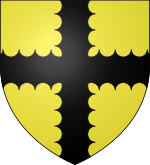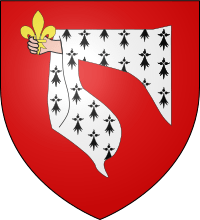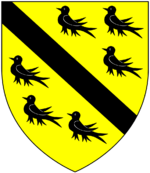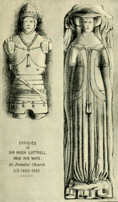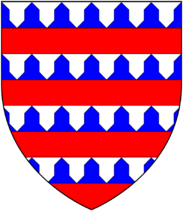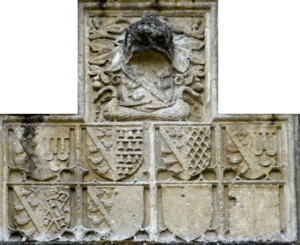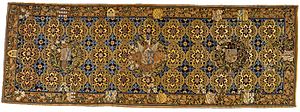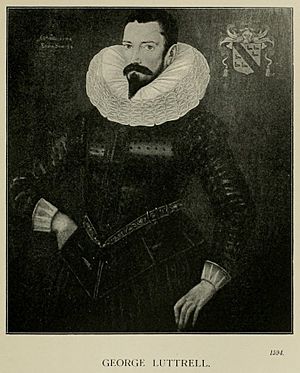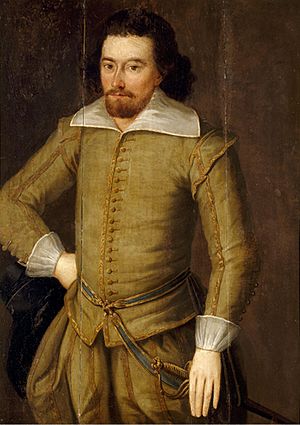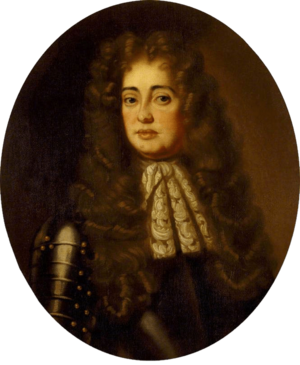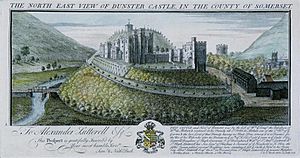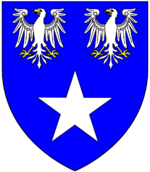Feudal barony of Dunster facts for kids
The feudal barony of Dunster was an important area of land in England. Its main center was Dunster Castle in Somerset. During the time of King Henry I (1100–1135), this barony, also called an "honour", included enough land to support forty knight's fees (areas of land given to knights in exchange for military service). It grew even larger later on. Around 1150, the main estates owned directly by the lord included Dunster, Minehead, Cutcombe, Kilton, and Carhampton in Somerset, plus Ham in Dorset.

Contents
- Who Owned Dunster Castle?
- The Mohun Family
- William de Moyon (died after 1090)
- William de Mohun, 1st Earl of Somerset (died around 1155)
- William de Mohun (died 1176)
- William de Mohun (died 1193)
- Reginald I de Mohun (1185–1213)
- Reginald II de Mohun (1206–1258)
- John de Mohun (1248–1279)
- John de Mohun, 1st Baron Mohun (1269–1330)
- Sir John de Mohun, 2nd Baron Mohun (c. 1320 – 1375)
- The Luttrell Family Takes Over
- The Herbert Family (Briefly)
- The Luttrell Family Returns
- Sir Hugh Luttrell (died 1521)
- Sir Andrew Luttrell (1484–1538)
- Sir John Luttrell (died 1551)
- Thomas Luttrell (died 1571)
- George Luttrell (died 1629)
- Thomas Luttrell (1583–1644)
- George Luttrell (died 1655)
- Francis Luttrell (1628–1666)
- Thomas Luttrell (died 1670)
- Col. Francis Luttrell (1659–1690)
- Tregonwell Luttrell (1683–1703)
- Col. Alexander Luttrell (1663–1711)
- Alexander Luttrell (1705–1737)
- The Fownes-Luttrell Family
- Henry Fownes Luttrell (c. 1722 – 1780)
- John Fownes Luttrell (1752–1816)
- John Fownes Luttrell (1787–1857)
- Henry Fownes Luttrell (1790–1867)
- George Fownes Luttrell (1826–1910)
- Alexander Fownes Luttrell (1855–1944)
- Geoffrey Fownes Luttrell (1887–1957)
- Geoffrey Walter Fownes Luttrell (1919–2007)
- Julian Fownes Luttrell (born 1932)
- The Mohun Family
- Sources
Who Owned Dunster Castle?
The Mohun Family
The Mohun family (also known as Mohon or Moion) came from a place called Moyon in Normandy, France. A historian named the Duchess of Cleveland wrote in 1889 that Wace (a Norman poet) said "old William de Moion had with him many companions" at the Battle of Hastings. He was a very important Norman lord.
Dugdale, another historian, said William de Mohun brought "forty-seven stout Knights." For his help, he was given fifty-five estates in Somerset, and two more in Wiltshire and Dorset. He chose Dunster, a place that was already well-known in Saxon times. He built his castle there, on the site of an older fortress used by West Saxon kings. People said its location was one of the most beautiful in England.
Here's how the Mohun family, the feudal barons of Dunster, passed down their title:
William de Moyon (died after 1090)

William de Moyon (died after 1090) was the first feudal baron of Dunster. He was the lord of Moyon in Normandy. He was also the Sheriff of Somerset in 1086. He started the English Mohun family. In the Domesday Book of 1086, it says he held the estate of "Torre" (Dunster) and had his castle there.
William de Mohun, 1st Earl of Somerset (died around 1155)
William de Mohun, 1st Earl of Somerset (died around 1155) was William's son. He was made the Earl of Somerset, but this title didn't pass to his children. He was a strong supporter of Empress Matilda in her war against King Stephen. People called him the "Scourge of the West" because of his fierce fighting.
William de Mohun (died 1176)
William de Mohun (died 1176) was the next heir. During his time, the barony included forty-six and a half knight's fees. These were held by different military tenants.
William de Mohun (died 1193)
William de Mohun (died 1193) was William's son. He was known as "The Crusader." He was a knight who died during the Third Crusade on his way to Jerusalem with Richard the Lionheart. His body was brought back to England and buried at Dunster Castle.
Reginald I de Mohun (1185–1213)
Reginald I de Mohun (1185–1213) was the heir. In 1205, he married Alice Brewer. She was one of four sisters who shared a large inheritance from their family. Alice brought him a huge estate. She also helped the new Salisbury Cathedral by providing all the marble needed for its construction for twelve years.
Reginald II de Mohun (1206–1258)
Reginald II de Mohun (1206–1258) was Reginald's son. He married twice. His first wife was Hawise Fleming. His second wife was Isabel de Ferrers, who was the widow of Gilbert Basset and daughter of William de Ferrers, 5th Earl of Derby.
John de Mohun (1248–1279)
John de Mohun (1248–1279) was Reginald II's grandson. His father, also named John de Mohun, died in Gascony before Reginald II.
John de Mohun, 1st Baron Mohun (1269–1330)

John de Mohun, 1st Baron Mohun (1269–1330) was John's son. He was the first in his family to be called to Parliament in 1299, which made him a baron. He fought for King Edward I in wars in Scotland and Gascony. In 1300, he was at the Siege of Caerlaverock. His coat of arms was described as "Yellow (gold), a cross engrailed black."
He also signed the Barons' Letter to the Pope in 1301. In this letter, he was called "John de Mohun, lord of Dunster." He married Anne Tiptoft and had many children. His oldest son, also named John, died before him.
Sir John de Mohun, 2nd Baron Mohun (c. 1320 – 1375)
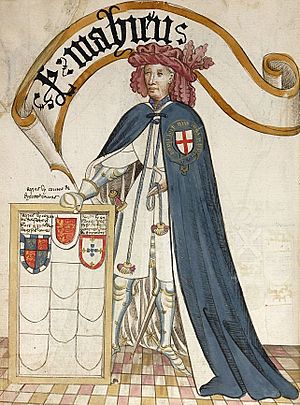

Sir John de Mohun, 2nd Baron Mohun (c. 1320 – 1375) was the last male heir of the Mohun family at Dunster. He was about 10 years old when he inherited the barony from his grandfather. Because he was a minor and a direct tenant of the King, he became a "ward" of the King. This meant the King controlled his land and marriage. The King sold his wardship to Henry Burghersh, who was the Bishop of Lincoln.
Henry Burghersh arranged for John to marry his half-niece, Joan of Burghersh (died 1404). Joan was a very strong-willed woman. She seemed to gain full control over her husband's estates. Sir John fought bravely at the Battle of Crécy in 1346. In 1348, he became one of the first 25 knights of the Order of the Garter.
Since they didn't expect to have any sons, Lady Mohun began to arrange for the future of their estates. In 1374, she sold the rights to Dunster Castle and other lands to Lady Elizabeth Luttrell (died 1395). Lady Mohun's husband died the next year, in 1375. In 1376, Lady Mohun finalized the deal. She kept the castle and lands for her lifetime, and after she died, they would go to Elizabeth Luttrell and her family.
Lady Elizabeth Luttrell never lived at Dunster. She died in 1395, before Lady Mohun. Dunster Castle was empty from 1376 until Lady Mohun's death in 1404. Lady Mohun spent most of her later life near the royal court. She was buried in the crypt of Canterbury Cathedral.
The Luttrell Family Takes Over
Lady Elizabeth Luttrell (died 1395)
Lady Elizabeth Luttrell (died 1395) was the wife of Sir Andrew Luttrell. She was also the daughter of Hugh de Courtenay, 2nd Earl of Devon. She bought the rights to the Mohun estates in 1376 for 5,000 marks (a large sum of money).
Sir Hugh Luttrell (c. 1364 – 1428)
Sir Hugh Luttrell (c. 1364 – 1428) was the son of Lady Elizabeth Luttrell. He married Catherine Beaumont (died 1435). Her family was very important in Devon. The Beaumont family's coat of arms can be seen in Dunster Church and on a special cloth called the Luttrell Table Carpet.
John Luttrell (c. 1394 – 1430)
John Luttrell (c. 1394 – 1430) was Hugh's son. Around 1422, he married Margaret Tuchet. He was likely buried at Bruton Priory.
Sir James Luttrell (1426/7-1461)
Sir James Luttrell (1426/7-1461) was John's son. He was only 3 or 4 when his father died. Because he was a minor and a direct tenant of the king, the king controlled his land and marriage. The king sold his wardship to Humphrey Stafford, 1st Duke of Buckingham, who then sold it to Sir Philip Courtenay. In 1450, Sir Philip arranged for James to marry his daughter, Elizabeth Courtenay (died 1493).
Sir James Luttrell died fighting for the Lancastrian side at the Second Battle of St Albans in 1461. After his death, he was accused of treason, and his lands were taken by the crown. In 1463, his lands were given to William Herbert.
The Herbert Family (Briefly)
- William Herbert, 1st Earl of Pembroke (died 1469)
- William Herbert, 2nd Earl of Pembroke (son) held the former Luttrell estates until King Richard III's reign ended in 1485.
The Luttrell Family Returns
Sir Hugh Luttrell (died 1521)
Sir Hugh Luttrell (died 1521) was the son of Sir James Luttrell. He joined Henry Tudor when he landed in Wales in 1485. He fought for Henry at the Battle of Bosworth. When Henry became King Henry VII, he reversed the treason charge against Sir Hugh's father. This meant Sir Hugh got his lands back from the Herbert family. The Herberts had never lived at Dunster.
Sir Hugh also helped stop a rebellion in Devon. In 1487, he was made a Knight of the Bath. He was Sheriff of Somerset and Dorset in 1488. He built the stone shields you can still see on the Gatehouse to Dunster Castle. These shields show the coats of arms of the Luttrell family and other families they were connected to. His monument in East Quantoxhead Church also shows his family's symbols.
He married twice. His first wife was Margaret Hill. They had two sons: Sir Andrew Luttrell (1484–1538), who inherited Dunster Castle, and John Luttrell, who started another branch of the family.
Sir Andrew Luttrell (1484–1538)
Sir Andrew Luttrell (1484–1538) was the eldest son of Sir Hugh and Margaret Hill. He was Sheriff of Somerset and Dorset in 1528. His monument is in East Quantoxhead Church. In 1514, he married Margaret Wyndham (died 1580). This marriage was arranged by their fathers.
Margaret's brother, Sir John Wyndham, visited his sister at Dunster. He met and married Elizabeth Sydenham, and became the ancestor of the important Wyndham family of Orchard Wyndham. The large "Luttrell Table Carpet" (5.5m by 1.9m) in Glasgow, which shows the Luttrell and Wyndham coats of arms, was likely made to celebrate their wedding.
Lady Luttrell was a powerful woman due to her large inheritance. She bought Dunster Priory after the Dissolution of the Monasteries, and it became part of the castle estate. Sir Andrew and Margaret had three sons:
- Sir John Luttrell (died 1551), the eldest, who was a soldier and died without sons. Dunster Castle then passed to his younger brother.
- Thomas Luttrell (died 1571), of Dunster Castle, the second son.
- Nicholas Luttrell (died 1592), the third son, who started other Luttrell family lines.
Sir John Luttrell (died 1551)
Sir John Luttrell (died 1551) was the eldest son. He was a main commander in the Scottish war. In 1545, he was knighted after capturing Leith. He was captured by the Scots in 1550 and had to be ransomed for £400. He married Mary Ryce but had no sons, only three daughters. Two-thirds of his estate went to his younger brother, Thomas.
Thomas Luttrell (died 1571)

Thomas Luttrell (died 1571) was Sir John's younger brother. In 1563, he became a Member of Parliament for Minehead, which was a "pocket borough" controlled by the Luttrell family. He sold some of the family's estates, probably to pay off debts. However, he gained a large estate from his wife, Margaret Hadley.
Thomas and Margaret were distantly related by blood and also "spiritually" because Thomas's mother was Margaret's godmother. This caused legal problems for their marriage. In 1557, they had to get special permission from the Pope to make their marriage official. They were officially remarried in East Quantockshead church in 1560. Their eldest son, George Luttrell, was born the next month.
George Luttrell (died 1629)
George Luttrell (died 1629) was Thomas's eldest son. He was a Member of Parliament for Minehead twice. He was also Sheriff of Somerset twice and built the pier in Minehead harbor. He started a big rebuilding project at Dunster Castle, designed by the architect William Arnold. This created the Jacobean mansion we see today. He married twice.
Thomas Luttrell (1583–1644)
Thomas Luttrell (1583–1644) was George's son. He was a Member of Parliament for Minehead and Sheriff of Somerset. He was a Puritan and, during the English Civil War, he defended Dunster Castle against the King. However, he was eventually forced to surrender it. He built a new harbor at Minehead at his own cost. He had one daughter and four sons. His portrait is still at Dunster Castle.
George Luttrell (died 1655)
George Luttrell (died 1655) was Thomas's eldest son. He was Sheriff of Somerset. Unlike his father, he supported the King during the Civil War. Dunster Castle was besieged by the Parliamentarians from 1645–46. In 1650, the castle's defensive walls were torn down by order of Oliver Cromwell. In 1651, the Castle was given back to George Luttrell. He married twice but had no children.
Francis Luttrell (1628–1666)
Francis Luttrell (1628–1666) was George's younger brother. He was a Member of Parliament for Somerset and Minehead. He married Lucy Symonds, who was the granddaughter of John Pym, a famous Member of Parliament whose attempted arrest by King Charles I helped start the Civil War. Francis and Lucy had three sons:
- Thomas Luttrell (died 1670), the eldest, who died young without children.
- Col. Francis Luttrell (1659–1690), the second son, who inherited the castle.
- Col. Alexander Luttrell (1663–1711), the youngest son, who later inherited the castle.
Thomas Luttrell (died 1670)
Thomas Luttrell (died 1670) was the eldest son of Francis. He died young and had no children.
Col. Francis Luttrell (1659–1690)
Col. Francis Luttrell (1659–1690) was Thomas's younger brother. He was a Member of Parliament for Minehead. He married Mary Tregonwell, a wealthy heiress. They made many fancy changes to the Castle, including a carved wooden staircase and a new dining room with detailed plaster ceilings. They had two daughters and a son, Tregonwell Luttrell (1683–1703), who died without children.
Tregonwell Luttrell (1683–1703)
Tregonwell Luttrell (1683–1703) was Francis's son. He died without children.
Col. Alexander Luttrell (1663–1711)
Col. Alexander Luttrell (1663–1711) was the uncle of Tregonwell. He fought in Flanders and was a Colonel in the Royal Marines. He was a Member of Parliament for Minehead. He married Dorothy Yard (1667–1723). After his death, his widow Dorothy managed the Dunster Castle estate and paid off debts. She also created new gardens and a less steep path to the castle. She even leveled the top of the old castle mound to make a bowling green.
Alexander Luttrell (1705–1737)
Alexander Luttrell (1705–1737) was Alexander's son. He was a Member of Parliament for Minehead. He was the last male in the Luttrell family line. In 1726, he married Margaret Trevelyan. They had one daughter and sole heiress, Margaret Luttrell (1726–1766). She married Henry Fownes, who then took the Luttrell name and coat of arms.
The Fownes-Luttrell Family
Henry Fownes Luttrell (c. 1722 – 1780)
Henry Fownes (c. 1722 – 1780) married Margaret Luttrell. He inherited the Luttrell estates, including Dunster Castle, and took the Luttrell name. He was High Sheriff of Somerset and a Member of Parliament for Minehead. They updated the Castle in the Georgian style, adding new windows and Chinese wallpaper. In 1755, Henry started a big landscaping project, creating pleasure gardens and a large deer park around the castle. He also built a decorative tower on Conygar Hill, which can be seen from the Castle.
John Fownes Luttrell (1752–1816)
John Fownes Luttrell (1752–1816) was Henry's eldest son. He was a Member of Parliament for Minehead. In 1782, he married Mary Drewe. They had 5 sons and 4 daughters.
John Fownes Luttrell (1787–1857)
John Fownes Luttrell (1787–1857) was John's eldest son. He was a Member of Parliament for Minehead and died unmarried.
Henry Fownes Luttrell (1790–1867)
Henry Fownes Luttrell (1790–1867) was John's younger brother and heir. He was also a Member of Parliament for Minehead. He died without children.
George Fownes Luttrell (1826–1910)
George Fownes Luttrell (1826–1910) was Henry's nephew. He was Sheriff of Somerset in 1874. His father, Lt-Col Francis Fownes Luttrell, fought at the Battle of Waterloo. George had a very large income. He carried out a major remodeling of the Castle with architect Anthony Salvin. This included adding modern servants' quarters, a new kitchen block, central heating, gas lighting, and a bathroom with hot water. He also added a library, gun room, and billiards room.
Alexander Fownes Luttrell (1855–1944)
Alexander Fownes Luttrell (1855–1944) was George's eldest son. He preferred to live at Court House, another family manor. He was a Captain in the Grenadier Guards. In the 1930s, the estate was about 13,000 acres. He chose not to use tax-saving methods, which later forced his son to sell the estate.
Geoffrey Fownes Luttrell (1887–1957)
Geoffrey Fownes Luttrell (1887–1957) was Alexander's eldest son. He was High Sheriff of Somerset in 1935. He was also the Private Secretary to the Governor-General of Australia. In 1918, he married Alys Anne Bridges, whom he met in Australia. His father gave them Dunster Castle, and they moved in. Geoffrey was interested in polo and created a polo ground at Dunster.
During World War II, he made Dunster Castle available as a recovery home for the Royal Navy. When his father died in 1944, the large death duties (taxes) made the estate difficult to manage. Geoffrey sold the estates but kept a tenancy for himself at the castle. He bought the castle and grounds back in 1954 and opened them to the public. He died in 1957, and his widow stayed at the castle until her death in 1974.
Geoffrey Walter Fownes Luttrell (1919–2007)
Lt-Col Sir Geoffrey Walter Fownes Luttrell (1919–2007) was Geoffrey's eldest son. He was a keen polo player. He inherited the Castle and grounds in 1957. In 1976, he donated the Castle and grounds to the National Trust. He died without children.
Julian Fownes Luttrell (born 1932)
Julian Fownes Luttrell (born 1932) is Geoffrey Walter's younger brother. He lives near Dunster and rents the Home Farm of Dunster Castle. He didn't fully agree with his brother's decision to donate the castle to the National Trust. In 1956, he co-founded a successful fork-lift truck company. He retired in 1973 and returned to Dunster. He has a daughter and a son, Hugh, who is studying estate management and hopes to continue the family's connection to the land. Julian still helps the National Trust by sharing his knowledge of the Castle's recent history.
Sources
- Burke's Genealogical and Heraldic History of the Landed Gentry, 15th Edition, ed. Pirie-Gordon, H., London, 1937, pp. 1437–9, Fownes-Luttrell of Dunster Castle
- Douglas, Sarah, A Souvenir Guide: Dunster Castle and Gardens, 2013
- Exmoor Oral History Archive, Dunster reminiscences of Julian Fownes Luttrell (born 1932), recorded in 2002
- Maxwell Lyte, Sir Henry, A History of Dunster and of the Families of Mohun and Luttrell, 2 Parts, London, 1909:
- Part 1, London, 1909
- Part 2, London, 1909 (Appendices)
- Sanders, I.J. English Baronies: A Study of their Origin and Descent 1086–1327, Oxford, 1960, p. 114, Dunster
- Somerset record Society, Vol.33, The Honour of Dunster
- Victoria County History, Somerset, Vol.1
- Vivian, Lt.Col. J.L., (Ed.) The Visitations of the County of Devon: Comprising the Heralds' Visitations of 1531, 1564 & 1620, Exeter, 1895, pp. 537–41, Luttrell


